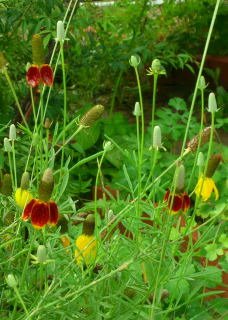 What’s blooming in the area: Illinois bundle flower, datura, white evening primrose, velvetweed, white sweet clover, golden hairy aster, hawkweed, milkweed, Queen Anne’s lace, bigleaf globeflower, tumble mustard, bindweed, buffalo gourd, toothed spurge, purple phlox, purple coneflower, roses, sweet pea, bouncing Bess, daylily, zinnias, Russian sage, trumpet creeper, silverlace vine. Large yucca down the road has bounced back after rain with remaining flower almost perpendicular. Corn has tassels in one vegetable patch, onions have heads in another.
What’s blooming in the area: Illinois bundle flower, datura, white evening primrose, velvetweed, white sweet clover, golden hairy aster, hawkweed, milkweed, Queen Anne’s lace, bigleaf globeflower, tumble mustard, bindweed, buffalo gourd, toothed spurge, purple phlox, purple coneflower, roses, sweet pea, bouncing Bess, daylily, zinnias, Russian sage, trumpet creeper, silverlace vine. Large yucca down the road has bounced back after rain with remaining flower almost perpendicular. Corn has tassels in one vegetable patch, onions have heads in another.What’s blooming in my garden, looking north: Black-eyed Susan, blanket flower, golden spur columbine, lance-leaf coreopsis, chocolate flowers, perky Sue, Hartweg evening primrose, fern-leaf yarrow, Mexican hat, miniature rose (Sunrise, Rise and Shine).
Looking east: Biennial yellow evening primrose, California poppy, winecup, coral bells, small and large flowered soapworts, coral beardtongue, Flanders poppy, sweet alyssum. Hollyhocks have lost their basal leaves here and in village.
Look south: Butterfly gladiola, rugosa rose.
Look west: Perennial four o’clock, white spurge, catmint, blue flax, sea lavender, balloon flower, purple ice plant, caryopteris.
Bedding plants: Dalhburg daisies, marigolds, sweet alyssum, snapdragons, petunias, profusion zinnias, supersweet 100 tomato, zucchini.
Animal sightings: Grey squirrel, power line bird, long tailed bird, two green hummingbirds, quail with young, stink bugs, aphids, small black ants swarm stalks of hawkweed, grasshoppers, bees on catmint, mosquitoes, sheep. Gopher has killed more tomatoes.
Weather: Cool nights, hot afternoons until storms moved in that left little water on Sunday, more on Monday, Tuesday and Wednesday. Hard rain Thursday with hail. Arroyos down the road had water in bottoms, near arroyo ran with brown, churning flood waters; whitish foam landed on bushes in old roadbed. Road and roadside flooded in many places, with standing water in a number of level yards. Rain on Friday flood roads and yards again. Mosquitoes hatched. Uphill neighbor brought in backhoes to rework the drive and raised front garden.
Weekly update: Promiscuous is the word used for corn with its easy ways of fertilizing other varieties, much to the dismay of seed companies who want to protect their patents and organic gardeners who fear contamination.
It’s a word that comes to mind when I see Mexican Hats take over my garden, in a mix of pure yellow, mahogany with yellow edges, gold streaked with red, and ochre blotched with caramel. The color variations are similar to other composites like marigolds which David Burpee crossbred before altering chromosomes of Black-eyed Susans into gloriosa daisies.
I bought two yellow flowered plants in 1995 from Santa Fe Greenhouse and put them by the garage, where their only water dripped off the roof. They survived, so I bought one the next year for my main garden. In 1997, I added three red plants. Today, there are still some yellow plants blooming by the garage, but at least fifty are in the garden, plus another ten or twenty on the perimeter and a half dozen or so at my front door.
I installed the first section of cedar fence in the spring of 2002, and the next year, yellow and red flowers appeared among the Maximilian sunflowers. Apparently, the fence stopped their flight and they dropped and dug themselves in. I extended the fence across the north in the late fall of 2004. Right on schedule, seeds blowing north were halted and this year red plants bloom on the far side of the garage.
They’re best seen from afar, especially when bees hover. Wiry stems hold the flowers above open clusters of grey-green leaves. Their narrow blooms are at their peak now, unbattered by the rains, but will look ragged when insects eat the petals and the disk flowers climb the cone from the base, row by row, leaving a brown center with no rays that reverts to dull olive when the seeds are released.
Ratibida columnaris, to give it its formal name, is native to the limestone soils of the plains. The pubescent stems and leaves have coarse textured hairs that absorb water from the air. The perennial roots are shallow, but young roots have a crook that keeps them tethered in the winds. With time, the roots go deeper and develop subterranean branches.
The mixed colors appear where I first planted them in my garden, and at the eastern fence. The yellow, which is recessive, have colonized the edge of the drive while the red are moving by themselves into empty spaces in the garden. Either the yellow apparently can tolerate areas with less water, or they cannot mutate and so stay one color.
Hybridizers have turned to other composites, with greater commercial possibilities. After I plated some new sunflower seeds some years ago, my natives began to show streaks of color. I don’t know if it was natural or a result of my seed. When sunlight filtered through one of nature’s burgundy blanketflowers, it diffused the color markings into the same coral as the surrounding beardtongues.
The variant sunflowers and blanketflowers are not as plentiful as Mexican Hats, because sunflowers depend on water in the air and the other are just not as hardy here. In the nineteenth century, revivalist Charles Finney called on women to pray in public in promiscuous assemblies. Coneflowers alone answer the muezzin.
Notes:
Finney, quoted by Douglas M. Strong, "The Crusade for Women’s Rights and the Formative Antecedents of the Holiness Movement," available on-line.
For Burpee’s role, see "The Legacy of W. Atlee Burpee," at burpee.com.
1 comment:
Wow!! Stunning outcomes from them!! I'm never contacting everybody else! go to the website
Post a Comment